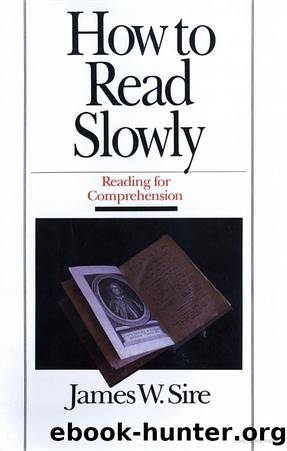How to Read Slowly by James W. Sire

Author:James W. Sire [Sire, James W.]
Language: eng
Format: epub
Tags: Non-Fiction, Reference, Writing
ISBN: 9780877883579
Amazon: 0877883572
Goodreads: 543841
Publisher: The Doubleday Religious Publishing Group
Published: 1978-01-01T05:00:00+00:00
The Secondary World by Bits and Pieces
What is there, then, to pay attention to? What do we find when we read? In fiction we find a dazzling array of things, and we never know until we read what unique combinations we will find. In general terms, however, the world of fiction is composed of plot, character and theme, and these come via the writerâs point-of-view and tone, his use of graphic description, symbol and allusion, and his narrative style, syntax and diction. In some stories we will be struck most by the plot; in others we will come away remembering the characters and almost forgetting what happened to them. In others still, our interest will be drawn to the profound insights into human nature and we will remember the theme of the storyâits striking presentation of an almost eternal truth.
As we read a novel or short story, the Secondary World comes to us in bits and pieces. Sentence two piles on sentence one; paragraph two on paragraph one; characters are gradually introduced; they begin to talk; the setting becomes obvious; the atmosphere builds; the plot begins to unfold as conflicts appear and become tied to people and events. Slowly, like a big, saggy balloon, the Secondary World fills to its full shape and form.
Let us look at the sorts of bits and pieces we find in these slowly expanding worlds of fiction. Knowing how these bits and pieces tend to function will focus our awareness and make us better observers.
In the sections to follow I have drawn several examples of plot, character, theme and symbol from both fiction and drama. Dramas contain many of the same aspects of fiction, and so when we âreadâ a drama we are, for all practical purposes, reading fiction. We are not, of course, experiencing the drama as drama, for that requires the whole dramatic machineryâstage, actors and so forth. But to the extent that we experience plays in the quiet of our study, we can employ the same reading techniques as in fiction.
Plot. Novels and short stories tell stories, and plot comes as close to being story as any of the bits and pieces we will consider. In other words, of all the bits and pieces plot is the biggest and perhaps the most important.
Simply defined plot is the âstructure of the incidents,â as Aristotle first described it. He added that plot is âthe imitation of the actionâ and proclaimed it âthe soul of a tragedy.â6 He was, of course, writing about the ancient Greek drama of Sophocles and Aeschylus, but what he said some twenty-three centuries ago applies amazingly well to todayâs narrative art.
The âstructure of the incidents,â that is, the order in which the events in a story are arranged, is its plot. And that plot qualifies and brings perspective to all else.
For example, the myth of Oedipus is told in chronological order. A certain child is born; his parents hear a prophecy and try to prevent it; the boy grows up, unwittingly fulfills the prophecy and eventually punishes himself for doing so.
Download
This site does not store any files on its server. We only index and link to content provided by other sites. Please contact the content providers to delete copyright contents if any and email us, we'll remove relevant links or contents immediately.
Fearfully and Wonderfully Made by Philip Yancey & Paul Brand(588)
Christian Ethics by Wilkens Steve;(572)
Numbers by Ronald B. Allen(504)
The World from 1450 To 1700 by Wills John E.;(500)
Christian Ethics: An Introduction to Biblical Moral Reasoning by Wayne Grudem(479)
How to Read Slowly by James W. Sire(458)
God and the Multiverse by Victor J. Stenger(449)
Morality by Jonathan Sacks(432)
Monastic Archaeology by Unknown(408)
The Disabled Church by Rebecca F. Spurrier;(397)
Jesus: A New Vision by Whitley Strieber(372)
Critical Writings by Joyce James;(368)
Death of the Doctor by Unknown(367)
Redeeming Sociology by Vern S. Poythress(366)
Amish Grace by Donald B. Kraybill & Nolt Steven M. & Weaver-Zercher David L(365)
The Technological System by Jacques Ellul(353)
Children of Lucifer; The Origins of Modern Religious Satanism by Ruben van Luijk(353)
The Catholic Case for Trump by Austin Ruse(334)
The Church in the Early Middle Ages by G.R. Evans(333)
